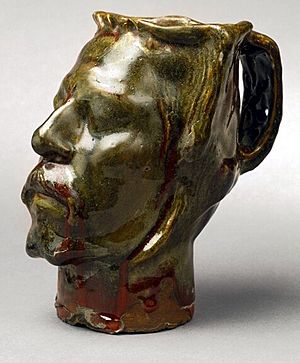Jug in the Form of a Head, Self-Portrait facts for kids

The Jug in the Form of a Head, Self-portrait is a unique artwork made by the French artist Paul Gauguin in 1889. It's often called the Jug Self-portrait. This special piece is made from glazed stoneware and shows Gauguin's face in a very strong and almost sad way.
Gauguin created this artwork after some difficult times in his life. In December 1888, he was visiting his friend, the artist Vincent van Gogh, in Arles. During this time, Van Gogh injured his ear. A few days later, Gauguin was in Paris.
In this artwork, Gauguin shows himself with closed eyes and an injured ear. Like many of his self-portraits, this piece seems to show feelings of sadness. The head looks a bit like a mask. The artwork reminds people of Van Gogh, especially because of the injured ear and the strong red color. Writer Naomi Margolis Maurer said the red color makes it look like "the suffering van Gogh."
The stoneware has soft green, gray, and olive colors that are sometimes hard to see in pictures. Its strong, real look comes from being a 3D object. Many art experts have said that photos don't truly show how powerful this artwork is when you see it in person. In 1989, critic Laurel Gasque wrote that this "macabre image" mixes life, stories, and history into a memorable picture of a troubled man.
Why Gauguin Made It
Several things in Gauguin's life led him to create this artwork. In November and December of the year before, he had lived with Van Gogh in Arles. Their goal was to start an art community together. Van Gogh really looked up to Gauguin and wanted them to be seen as equals. However, Gauguin was often proud and bossy, which frustrated Van Gogh.
Their friendship became difficult. Gauguin became worried about Van Gogh's behavior and decided to leave.
What the Artwork Means
This artwork uses ideas from Romanticism and Symbolism. It also includes symbols from Christian stories and old myths. It brings to mind figures like Christ, John the Baptist, and Orpheus. These figures were all seen as heroes who suffered for their strong beliefs.
During this time, Gauguin often painted himself to look like Christ. He did this to show that he felt like a martyr, someone who suffers for their beliefs. Gauguin was unhappy with the focus on money he saw around him. He felt disconnected from people who bought art and from other artists who didn't like his strong personality. Younger artists who had once followed him started to go their own way, and Gauguin felt a bit left out.
About another similar self-portrait, Christ in the Garden of Olives, Gauguin wrote:
There I have painted my own self portrait ... but it also represents the crushing of an ideal, and a pain that is both divine and human, Jesus is totally abandoned; his disciples are leaving him, in a setting as sad as his soul.
Gauguin used a special technique for this artwork that came from the Far East. He used dripping paint on glazed stoneware, which was inspired by Japanese artists from the Takatori region. The idea of combining a head and a jug came from Peruvian pottery. He likely saw these types of pieces that his mother had collected when he was a child.
Images for kids
See also
 In Spanish: Jarra en forma de cabeza, autorretrato para niños
In Spanish: Jarra en forma de cabeza, autorretrato para niños





